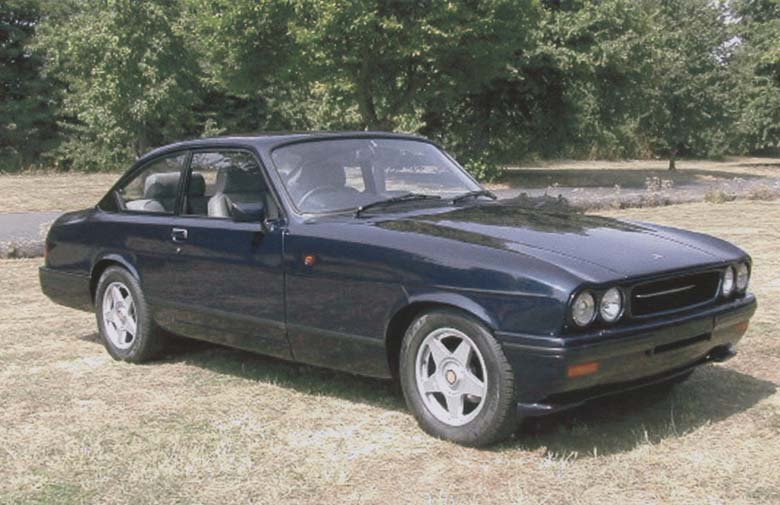Presenting his hilarious review of the Bristol Blenheim 3G. Honestly, how many of us here know of this car?
Oh gosh, is it Sunday? What, already? Er, crikey. Bit embarrassing actually because I haven’t actually driven anything this week. Well, nothing you’d want to read about.
I had a brief go in the new Toyota Land Cruiser but I could never fill a whole column with that. I couldn’t even fill a sentence. It just needs one word: “Mumsy.”
Then there was the new Renault Mégane, which has just been voted European car of the year. This is the most prestigious award in all of motoring. Were the fifty or so judges plied with so much free champagne that they became incapable of making a rational decision? Their choices over the years have been either bewildering, obtuse or bonkers. There was the Renault 9, for instance, and the Rover SD1, which was notable only for going like cricket — it stopped every time it looked like rain. And exactly how much Châteauneuf-du-Pape had they consumed when they voted in the Talbot Horizon or the Talbot Alpine or the Citroën XM? With the Mégane, though, they have surpassed themselves. Making this the car of the year rather than, say, the Mazda 6, is like saying no to Saving Private Ryan and awarding the Oscar to Police Academy 7. Actually, that’s quite a good metaphor. The Mazda is like Saving Private Ryan: important and a major departure for its creator. And the Renault Mégane is like Police Academy 7: colourful and a bit daft.
Deciding whether you want one depends entirely on whether you like its enormous rear end. If you do, go ahead. If you don’t, buy a Ford Focus or a VW Golf, or anything really, except last year’s car of the year, the Peugeot 307. And there we are, you see. Already I’m out of things to say.
So let’s move on, shall we, to a car that I have not driven this week or indeed ever: the Bristol Blenheim 3G.
I tried to drive it. I asked the man who brought it over if I could have the keys but he was most insistent: “You can only look at it.” Well, I could have done that using an internet. “I don’t care. That’s what my boss says.” Ah, his boss: the legendary Tony Crook.
He was the man who rescued Bristol’s car division when the government merged the aeroplane business into the British Aircraft Corporation. And he was the man who throughout the 1950s used to tour the motor show stands of his competitors — Fraser Nash and Rolls-Royce — dressed as an Arab.
“Oh, it was great fun. I used to order five or six Rolls-Royces at a time and once I tried to buy all the cars from the Fraser Nash stand.
I insisted they sold all of them to me that day. And I had a suitcase full of money to prove I meant business. It wasn’t really money. It was a few fivers with lots of lavatory paper underneath but it had them fooled.”
Of course, Rolls was used to him because in the 1940s he used to pay tramps to sit on its stand at the London motor show. Why? “Well, just to annoy them really.”
He’s a wonderful, wonderful man and I love him dearly but he’s from a bygone age, really, and that’s fitting because so are his cars. I drove one only once, back in the early 1990s, and can remember to this day Crook’s face when I pointed to the window winders and said: “It doesn’t have electric windows.”
“My dear chap,” he said, looking like I’d just stuck a needle in his eye, “why should it? People have arms.”
He hasn’t changed. I quizzed him last week about his new car — the Fighter — which is due to be launched next year, asking if it has a monocoque construction or perhaps something even more modern. “Why should it?” he asked again. “Our engineers had a look at that but there didn’t seem any point so it still has a separate chassis. Jolly good it is, too.”
That’s the response you get to pretty well any technical question. When I asked about the differences between the Blenheim S and the normal car, he said: “Oh, the S is a sporty job, different camshaft and tighter. That sort of thing.” And the Blenheim 3G? “Yes, that runs on gas.”
Does it work? Well, I don’t know because Crook’s enormous minder had the keys in his pocket and wouldn’t hand them over. But he did let me climb inside and I could not believe the scene that awaited me.
This car looked like it had been made by me. And I simply cannot think of a worse thing to say. It was awful. Beyond awful. The handle, for instance, which you pull to open the glove box was not a handle at all. It appeared to be a 3in length of flex from a 1940s telephone receiver which had been crudely screwed to the wood by someone with the carpentry skills of Alfred, Lord Tennyson. The screws weren’t level. They weren’t the same. And their heads were exposed, burred and scarred. Like they would be if they’d been put there by a poet.
So you see, I’ve found more to say about the handle on the Bristol’s glove box than I found to say about the whole Toyota Land Cruiser. And I haven’t even got to the switches yet.
The switches were astonishing. Not only did they appear to have been lifted from my grandfather’s mahogany gramophone, which was the size of a sofa, but it seems they’d been positioned on the dashboard in a team-building game of pin the tail on the donkey.
Either that or someone fires them at the dash using a catapult and then nails them down wherever they land. “Where’s the switch for the lights?” I asked the minder. “Dunno mate, could be anywhere.” Absolutely. I couldn’t find it but then I didn’t look in the passenger footwell or behind the sun visor.
I also didn’t find the switch for the heated rear window, but having examined the glass I’m not sure it has one. This wouldn’t be entirely surprising. It also doesn’t have an airbag, satellite navigation, heated seats or indeed anything. On its official website, the company talks only about the excellent optical quality of the glass. Well, it’s certainly unencumbered with heating elements.
So you’re not buying a Bristol for the number of gizmos or the way those that you do get are attached to the car. I carefully examined the front air splitter, for instance, and deduced that it must have been put there by a horse.
No, really. As Sherlock Holmes himself advised: “When you have eliminated the impossible” — and it is impossible to imagine a human making such a hash of it — “then what remains, no matter how implausible, must be the truth.” So it was a horse.
And then there’s the engine. It’s a 5.9 litre V8 that is still made in a small corner of Chrysler’s Detroit engine plant especially for lil’ ol’ Bristol. It’s not green, powerful, economical, modern or quiet but it will last for a long time.
And the same goes for the chassis, which first saw the light of day in Ben-Hur’s chariot. I should also draw your attention to the styling which appears to have been done by . . . well, me again actually, and the £145,000 price tag which is, let’s say, hopeful.
Customers include Richard Branson, Liam Gallagher and Jeremy King, former owner of the Ivy, the upmarket London restaurant. They sell 150 a year and it’s hard to see why.
What’s the appeal? What am I missing? Why would anyone buy a Bristol and not a Bentley Arnage T or an Aston Martin Vanquish or a Range Rover or a Mini or a Kia Sedona or a Toyota Prius even? Well, going back to my film analogy, Bristol is Marlon Brando. Way past its sell-by date, fat and possibly a bit wet in the panty department. But for no memorable reason, still a huge name, still a bankable star and still, as a result, icy cool.
There’s only one reason why you would ever buy a Bristol: so that when anyone asks what you drive, you can tell them.
![Clap [clap] [clap]](https://www.theautomotiveindia.com/forums/images/smilies/Clap.gif) you..The points you made my views tilt towards your views.
you..The points you made my views tilt towards your views.![Clap [clap] [clap]](https://www.theautomotiveindia.com/forums/images/smilies/Clap.gif) you..The points you made my views tilt towards your views.
you..The points you made my views tilt towards your views.

![Thumbs Down [thumbsdown] [thumbsdown]](https://www.theautomotiveindia.com/forums/images/smilies/Thumbs%20Down.gif)
![Confused [confused] [confused]](https://www.theautomotiveindia.com/forums/images/smilies/Confused.gif) They have violated a whole lot of laws even. Just that you might not have noticed.
They have violated a whole lot of laws even. Just that you might not have noticed.![Laugh [lol] [lol]](https://www.theautomotiveindia.com/forums/images/smilies/Laugh.gif) (ans then, he grins and says, "Sorry!")
(ans then, he grins and says, "Sorry!")


